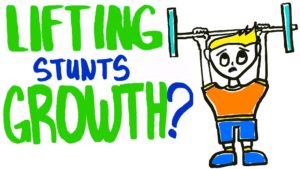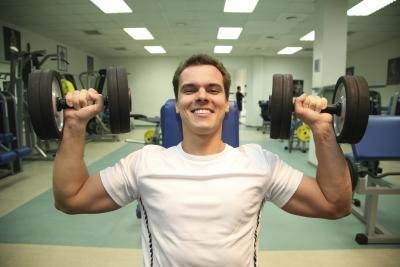Starting Out
Although teen boys may be excited to hit the weights, they should begin by mastering body-weight exercises. Injuries occur to teens when weight lifting using incorrect technique or attempting to lift weights that are too heavy. Begin with body-weight exercises to improve coordination and allow the musculoskeletal system to adapt to the stress of lifting. A body-weight lifting plan that targets all the major muscle groups includes pushups, pullups, squats, lunges, calf raises, hip bridges and crunches. A safe workout volume to begin with includes completing one to two sets of 8 to 15 repetitions.
After a teen guy has been completed the body-weight section of the workout plan, he can start to kick up the intensity by lifting weights. Some equipment found in gyms and fitness facilities can be the wrong size for a teenage boy. The University of Rochester Medical Center recommends that when it comes time to incorporate additional resistance into their workouts, teenage boys should select free weight exercises. And, before moving to free weights, KidsHealth.org recommends that teen boys go through the movements with a trainer without any additional weight to ensure proper technique. A full-body free-weight workout plan includes chest press, bent-over row, shoulder press, biceps curls, triceps extensions, dumbbell squats, dumbbell lunges, calf raises with weights, deadlifts and crunches. Once the teen masters the exercises, they can increase the weight they’re using and do two to three sets of 10 reps.
Building Muscle Mass
The hormonal changes that occur as a teen boy reaches puberty make a significant impact on whether they can put on notable muscle mass. Testosterone is a hormone that promotes muscle building and masculine traits. Before puberty, male teens lack the necessary testosterone levels to put on real mass — they’ll gain strength, but their muscles won’t become larger or bulky. After reaching puberty, however, they can put on more bulk because of the natural increase of testosterone.
Safety Considerations for Teens
During a boy’s teen years, their bones, joints, muscles and tendons are in the process of growing. As a result, they’re more susceptible to injury. Although they may be interested in lifting a heavy amount of weight or to follow a body-building routine, don’t incorporate high intensity or high volume programs shouldn’t the teen has surpassed puberty. Before puberty, teen guys lack the hormones needed for significant muscle-building. In addition, teen guys should avoid maximum-weight lifts, which involve trying to maximize how much weight can be lifted one time. During a lift, if it’s painful or uncomfortable for the teen, have him stop immediately. And, for teen guys eager to gain mass, patience is key. The use of anabolic steroids is linked to several significant health issues — wait for the testosterone to kick in to grow muscle mass naturally.
Discover more from ReviewFitHealth.com
Subscribe to get the latest posts sent to your email.

